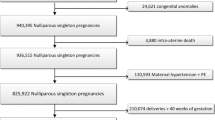Abstract
Purpose
To estimate the frequency of fetal programming phenotypes among women with low BMI and the success of these programming patterns-to determine if small for gestational age (SGA) is a biologically adaptive mechanism to improve chances for infant survival.
Methods
We examined the frequency of fetal programming phenotypes: SGA, large for gestational age (LGA), and adequate for gestational age (AGA) among 1,063,888 singleton live births from 1978 to 1997. We also estimated the success of fetal programming phenotypes using neonatal death as the primary study outcome.
Results
Underweight gravidas with AGA and LGA babies had elevated risk of neonatal mortality when compared to normal weight mothers, while the risk for neonatal mortality among mothers with SGA babies was reduced.
Conclusions
The variation in relative degrees of fetal programming patterns and success observed suggests that underweight mothers are more likely to succeed in programming SGA fetuses rather than any other phenotype.

Similar content being viewed by others
References
Abenhaim HA, Kinch RA, Morin L, Benjamin A, Usher R (2007) Effect of prepregnancy body mass index categories on obstetrical and neonatal outcomes. Arch Gynecol Obstet 275:39–43. doi:10.1007/s00404-006-0219-y
Doherty DA, Magann EF, Francis J, Morrison JC, Newham JP (2006) Pre-pregnancy body mass index and pregnancy outcomes. Int J Gynaecol Obstet 95:242–247. doi:10.1016/j.ijgo.2006.06.021
Sukalich S, Mingione MJ, Glantz C (2006) Obstetric outcomes in overweight and obese adolescents. Am J Obstet Gynecol 195:851–855. doi:10.1016/j.ajog.2006.06.070
Cnattingius S, Bergstrom R, Lipworth L, Kramer MS (1998) Prepregnancy weight and the risk of adverse pregnancy outcomes. N Engl J Med 338:147–152. doi:10.1056/NEJM199801153380302
Sahu MT, Agarwal A, Das V, Pandey A (2007) Impact of maternal body mass index on obstetric outcome. J Obstet Gynaecol Res 33:655–659. doi:10.1111/j.1447-0756.2007.00646.x
Salihu HM, Mbah AK, Alio AP, Kirby RS (2008) AGA-primed versus SGA-primed uterus and the success of subsequent in utero fetal programming. Obstet Gynecol 111:935–943
Herman AA, McCarthy BJ, Bakewell JM, Ward RH, Mueller BA, Maconochie NE et al (1997) Data linkage methods used in maternally-linked birth and infant death surveillance data sets from the United States (Georgia, Missouri, Utah and Washington State), Israel, Norway, Scotland and Western Australia. Paediatr Perinat Epidemiol 11(Supp 1):5–22. doi:10.1046/j.1365-3016.11.s1.11.x
Martin J, Curtin S, Saulnier M, Mousavi J (2003) Development of the matched multiple birth file. 1995–1998 matched multiple birth dataset. NCHS CD-ROM series 21, no. 13a. National Center for Health Statistics, Hyattsville
Herman AA, Yu KF (1997) Adolescent age at first pregnancy and subsequent obesity. Paediatr Perinat Epidemiol 11(Suppl 1):130–141. doi:10.1046/j.1365-3016.11.s1.5.x
McTigue K, Larson JC, Valoski A, Burke G, Kotchen J, Lewis CE et al (2006) Mortality and cardiac and vascular outcomes in extremely obese women. JAMA 296:79–86. doi:10.1001/jama.296.1.79
NHLBI (1998) Obesity education initiative clinical guidelines on the identification, evaluation, and treatment of overweight and obesity in adults: the evidence report. Bethesda, MD: US Department of Health and Human Services, Public Health Services, National Institutes of Health, National Heart, Lung, and Blood Institute
Physical status: the use, interpretation of anthropometry (1995) Report of a WHO Expert Committee. World Health Organ Tech Rep Ser 854:1–452
WHO expert consultation (2004) Appropriate body-mass index for Asian populations and its implications for policy and intervention strategies. Lancet 363(9403):157–163
Taffel S, Johnson D, Heuser R (1982) A method of imputing length of gestation on birth certificates. Vital Health Stat 2 93:1–11
Piper JM, Mitchel EF Jr, Snowden M, Hall C, Adams M, Taylor P (1993) Validation of 1989 Tennessee birth certificates using maternal and newborn hospital records. Am J Epidemiol 137:758–768
Wingate MS, Alexander GR, Buekens P, Vahratian A (2007) Comparison of gestational age classifications: date of last menstrual period vs. clinical estimate. Ann Epidemiol 17:425–430. doi:10.1016/j.annepidem.2007.01.035
Alexander GR, Kotelchuck M (1996) Quantifying the adequacy of prenatal care: a comparison of indices. Public Health Rep 111:408–418 (discussion 419)
Alexander GR, Cornely DA (1987) Prenatal care utilization: its measurement and relationship to pregnancy outcome. Am J Prev Med 3:243–253
Zeger SL, Liang KY (1986) Longitudinal data analysis for discrete and continuous outcomes. Biometrics 42:121–130. doi:10.2307/2531248
Clayton D, Hills M (1993) Statistical models in epidemiology. Oxford University Press, Oxford
Barker DJ (2003) Coronary heart disease: a disorder of growth. Horm Res 59(Suppl 1):35–41. doi:10.1159/000067843
Mahajan SD, Singh S, Shah P, Gupta N, Kochupillai N (2004) Effect of maternal malnutrition and anemia on the endocrine regulation of fetal growth. Endocr Res 30(2):189–203. doi:10.1081/ERC-200027380
Stein AD, Zybert PA, van der Pal-de Bruin K, Lumey LH (2006) Exposure to famine during gestation, size at birth, and blood pressure at age 59 y: evidence from the Dutch Famine. Eur J Epidemiol 21(10):759–765. doi:10.1007/s10654-006-9065-2
World Health Organization (2007) Nutrition and food security: body mass index. http://www.euro.who.int/nutrition/20030507_1. Accessed 17 September 2008
Chelbi ST, Vaiman D (2008) Genetic and epigenetic factors contribute to the onset of preeclampsia. Mol Cell Endocrinol 282(1–2):120–129. doi:10.1016/j.mce.2007.11.022
Reik W, Constancia M, Fowden A, Anderson N, Dean W, Ferguson-Smith A, Tycko B, Sibley C (2003) Regulation of supply and demand for maternal nutrients in mammals by imprinted genes. J Physiol 547(1):35–44. doi:10.1113/jphysiol.2002.033274
Dommisee J, Tiltman AJ (1992) Placental bed biopsies to placental abruption. Br J Obstet Gynaecol 99:651–654
Acknowledgments
This work was supported by an obesity grant from the Flight Attendant Medical Research Institute (FAMRI) to Dr. Hamisu Salihu (Last author). The funding agency did not play any role in any aspect of the study. We thank the Missouri Department of Health and Senior Services for providing the data files used in this study.
Conflicts of interest statement
The authors declare that they have no conflicts of interest with this research.
Author information
Authors and Affiliations
Corresponding author
Rights and permissions
About this article
Cite this article
Belogolovkin, V., Alio, A.P., Mbah, A.K. et al. Patterns and success of fetal programming among women with low and extremely low pre-pregnancy BMI. Arch Gynecol Obstet 280, 579–584 (2009). https://doi.org/10.1007/s00404-009-0965-8
Received:
Accepted:
Published:
Issue Date:
DOI: https://doi.org/10.1007/s00404-009-0965-8




